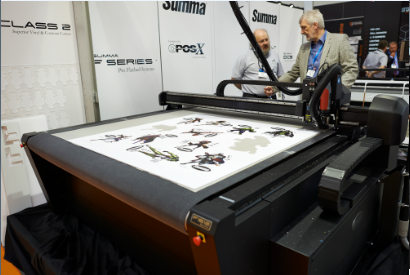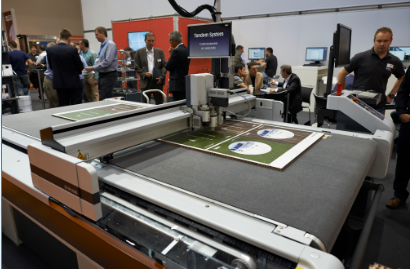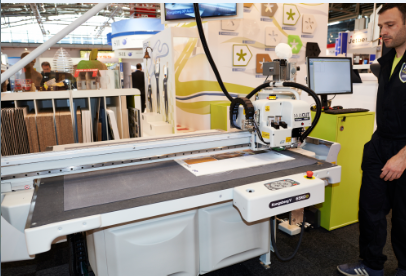…could be the start of something big. Nessan Cleary brings you up to speed on cutting tables for finishing rigid materials.
Many print jobs will need some form of finishing to turn them into saleable products. When it comes to rigid materials this usually means a cutting table, capable of cutting out shapes, or of adding creasing or V-cuts to create folds for packaging or 3D items such as POP display boxes. This kind of work is often done manually, but as volumes build up then the ability of a cutting table to repeat the same precise cuts continually starts to make economic sense.
We’re seeing that many printers that have typically bought cutting tables to fulfill a particular contract for display graphics work etc, have then used them to evolve into other areas, including industrial applications, which can include anything from making wood furniture to cutting out switch panels for other manufacturers.
Finishing kit manufacturers have recognised the opportunity for both their own sales, and those of their customers, in providing reasonably priced cutting tables.
Esko produces a wide range of cutting tables, including the latest C series, which Paul
Bates, sales manager for Esko in the UK, says were developed to keep pace with newer inkjet large-format printers. The first of this series is the C64, which can handle various materials from paper and textiles up to fluted board, plastics, aluminium composites and corrugated up to triple-wall thickness. The bed is big enough to take boards up to 3.2 x 3.2m but Bates says that customers also use it to cut two sheets side by side to gain greater productivity.
The C series uses a carbon composite cross beam to give it lateral strength. Bates says that this is necessary because there can be a certain amount of movement with steel beams over bigger widths, which affects the quality. He also says that the carbon composite beam will be used with the rest of the Kongsberg range “because it’s lighter so there's less wear and tear on the gearbox”.
However, Esko has also hedged its bets with a new, cheaper series of cutting tables, the Kongsberg V. This is available in two versions, one for the packaging market and one configured for sign and display users. The latter comes with a MultiCut tool head that includes a vision system. Bates explains: “We were missing out on a big chunk of the market because they couldn't justify the cost of the bigger tables.” It’s a slower table, having just a 1Kw router but Bates says it has the same robustness.
Esko is also in the process of developing a new front-end program for its tables, due out early next year. Bates says that the original operating system was developed for making prototypes and samples but for graphics work most customers use the iCut software that works alongside this. These will now be merged into a single front-end, that will be easier to use as well as being more productive. Bates says there is a lot of intelligence in it: “It will tell you how long a job will take and how long before it's finished.” Initially it will be offered with the C-series before being added to the rest of the range and will be a free update for anyone with a maintenance contract.

The main competitor is Zund, which produces both the larger G3 series and an entry level S-series. The G3 models range in size from 1330 x 1600mm up to 3210 x 3200mm, with extension tables to cope with bigger materials and optional rollers and unwinders. They can take up to three modules, including a universal module that accepts all the tools that Zund offers. There’s also a 1kW router module, with automated dust extraction, as well as a punch module, capable of punching up to 10 holes per second, and a marking module that takes a number of drawing and plotting pens. There’s also an optional camera system for registration. There are several specialised tools, including a universal cutting tool, oscillating cutters, a V-cutter and a 1Kw router.
Zund’s budget model is the S3, which ranges in size from 1330 x 800mm up to 1800 x 1600mm. It’s possible to combine two tool modules together, from a choice of a universal holder, camera system, kiss cutting and marketing modules. The tools themselves include universal, oscillating and kiss cutting tools.
At the Fespa Digital show earlier this year, Zund demonstrated a new tandem mode to split the bed into two, with the S3 cutting boards on one half of its bed, with another being loaded on the other half, a useful demonstration of the productivity benefits of buying a larger table than might otherwise by needed.
The Korean manufacturer Dyss has two tables, the X5 and the larger X7, which is becoming popular in the UK thanks to its competitive pricing. The X7 comes in various sizes from 1650 x 2450mm up to 3250 x 3050mm and takes media up to 50mm thick. There’s a choice of two cutting heads: the triple head will hold three tools at once; the super head only takes one standard cutting tool but also includes a routing spindle. There’s an optional K-cut vision camera system that can take into account distortions in the media and calculate new cutting paths accordingly. The X7 can also be fitted with an automatic roll feeder and conveyor system as well as an automatic feeder for stacked sheets.
The X5 series is really aimed at packaging rather than sign and display companies but will handle substrates such as folding cartonboard, corrugated and PETG. It has a knife cutter and creaser and takes the KCut vision system. Sizes range from 1300 x 1000mm up to 1600 x 2500mm.
These are distributed in the UK by AG Cad, which has added its own KaseMake software. This is suitable for designing 3D items such as packaging or POP displays. It comes with a library of designs and the latest version includes a 3D preview of the design that can be rotated through 360 degrees.
AG CAD also makes its own KaseMake KM7 range of cutting tables, which are mainly designed for prototyping and short run production, but are a good budget option to the larger tables. It comes with a tool head that holds two interchangeable tool modules and a pen. The tools include a drag knife, creaser, oscillating knife and an optional router said to be capable of cutting acrylic and thin aluminium.
Summa sells the F1612, which has a pneumatically driven conveyor belt that can feed material through while cutting. It has a cutting width of 160cm with a 120cm long bed. It will run at 1000mm/sec. It comes with an optical marking system for registration and a drag knife. There’s an optional tangential module that allows for greater cutting force, and a number of tools for use with this for kiss cutting, contour cutting and creasing, as well as cutters for specific media. We’ll come back to finishing later in the year with a look at solutions for flexible substrates.

material through while cutting. It has a cutting width of 160cm with a 120cm long bed. It will run at 1000mm/sec. It comes with an optical marking system for registration and a drag knife. There’s an optional tangential module that allows for greater cutting force, and a number of tools for use with this for kiss cutting, contour cutting and creasing, as well as cutters for specific media. We’ll come back to finishing later in the year with a look at solutions for flexible substrates.
ROUTERS
Some of you may want to look at a CNC router. Traditionally these were bought for more heavy-duty materials. But Julian Sage, sales director of Tekcel UK, says that nowadays most routers can handle the same lightweight materials that would be used with a cutting table, adding: “But those tables aren't capable of cutting through aluminium and steel.”
He points out that routers have all the tools you would find on a cutting table, including drag knives, tangential blades and 45 degree cutting tools. The Tekcel range have automated tool changers, with access to the full set of tools rather than just a handful in a modular carrier.
Sage says they are very accurate, and are routinely used in demanding industries such as aerospace, adding: “We have precision-driven ball screw drives and digital servo motors so the accuracy is absolutely spot on.”
The prices range from £45,000 - £90,000 though Sage estimates an average sign and graphics configuration to be around £65,000. He says that the machines are versatile and customers have used them to expand into other industries such as plastic fabrication.
This is a key consideration in justifying the cost of a cutter, be it a router or a table as these devices can help to take a business into new areas, something well worth considering in the current economic uncertainty.


